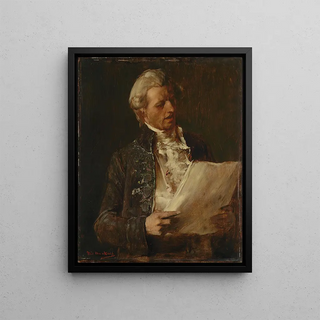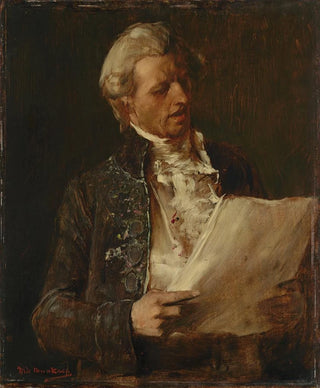Art print | Study of a singer for the painting Mozart Dying - Mihály Munkácsy


View from behind

Frame (optional)
In the vibrant universe of art, certain works stand out for their ability to capture moments of intense emotion, evoke memories, and transcend time. "Étude de chanteur pour le tableau Mozart mourant" by Mihály Munkácsy is one such creation. This painting, both poignant and rich in detail, immerses us in the intimacy of a moment where music and death meet. The art print of this piece not only allows appreciation of the artist's technical mastery but also enables one to feel the depth of the emotions he aimed to convey. Contemplating this work invites the viewer to explore universal themes of life, death, and the fleeting beauty of art.
Style and uniqueness of the work
Mihály Munkácsy, through "Étude de chanteur pour le tableau Mozart mourant," demonstrates remarkable skill in playing with light and shadow, creating an atmosphere that is both dramatic and emotional. The choice of colors, ranging from dark tones to brighter shades, enhances the scene's intensity. The singer's face, filled with passion and melancholy, seems to tell a story that resonates deeply with the viewer. Every detail, from the drapery of the clothing to the expressions on the faces, is carefully crafted, reflecting meticulous attention to the depiction of the human. This painting is not merely a study; it becomes a true tableau of life, where each element contributes to the whole and invites reflection on the nature of existence.
The artist and his influence
Mihály Munkácsy, born in Hungary in the 19th century, is often regarded as one of the greatest painters of his era. His career is marked by an relentless pursuit of artistic perfection and a desire to explore profound and complex themes. Influenced by the great masters of painting, Munkácsy developed a style that is uniquely his own, combining realism and romanticism. His works, often charged with emotion, testify to a keen sensitivity to human suffering and the beauty of the human condition.

Matte finish

View from behind

Frame (optional)
In the vibrant universe of art, certain works stand out for their ability to capture moments of intense emotion, evoke memories, and transcend time. "Étude de chanteur pour le tableau Mozart mourant" by Mihály Munkácsy is one such creation. This painting, both poignant and rich in detail, immerses us in the intimacy of a moment where music and death meet. The art print of this piece not only allows appreciation of the artist's technical mastery but also enables one to feel the depth of the emotions he aimed to convey. Contemplating this work invites the viewer to explore universal themes of life, death, and the fleeting beauty of art.
Style and uniqueness of the work
Mihály Munkácsy, through "Étude de chanteur pour le tableau Mozart mourant," demonstrates remarkable skill in playing with light and shadow, creating an atmosphere that is both dramatic and emotional. The choice of colors, ranging from dark tones to brighter shades, enhances the scene's intensity. The singer's face, filled with passion and melancholy, seems to tell a story that resonates deeply with the viewer. Every detail, from the drapery of the clothing to the expressions on the faces, is carefully crafted, reflecting meticulous attention to the depiction of the human. This painting is not merely a study; it becomes a true tableau of life, where each element contributes to the whole and invites reflection on the nature of existence.
The artist and his influence
Mihály Munkácsy, born in Hungary in the 19th century, is often regarded as one of the greatest painters of his era. His career is marked by an relentless pursuit of artistic perfection and a desire to explore profound and complex themes. Influenced by the great masters of painting, Munkácsy developed a style that is uniquely his own, combining realism and romanticism. His works, often charged with emotion, testify to a keen sensitivity to human suffering and the beauty of the human condition.






